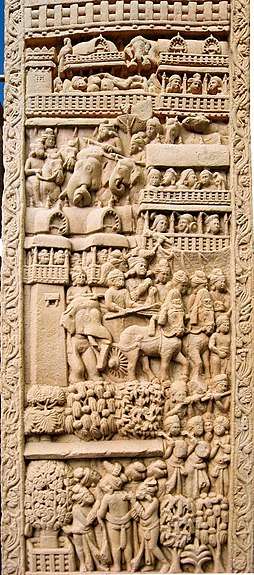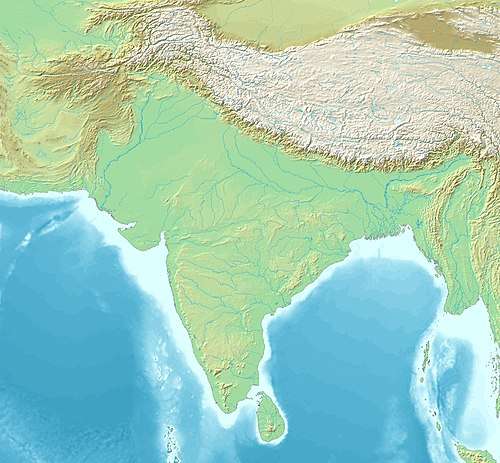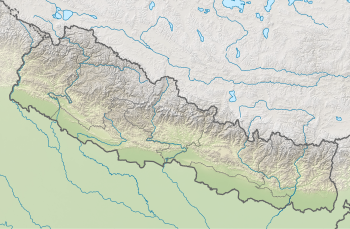Kapilavastu (ancient city)
Kapilavastu was an ancient city on the Indian subcontinent which was the capital of the clan of the Shakyas. King Śuddhodana and Queen Māyā are believed to have lived at Kapilavastu, as did their son Prince Siddartha Gautama until he left the palace at the age of 29.[2]
| Pilgrimage to |
| Buddha's Holy Sites |
|---|
 |
| The Four Main Sites |
| Four Additional Sites |
| Other Sites |
|
| Later Sites |
|
Buddhist texts such as the Pāli Canon claim that Kapilavastu was the childhood home of Gautama Buddha, on account of it being the capital of the Shakyas, over whom his father ruled.[2] Kapilavastu is the place where Siddhartha Gautama spent 29 years of his life. According to Buddhist sources Kapilvastu was named after Vedic sage Kapila.[3][4]
Search for Kapilavastu
The 19th-century search for the historical site of Kapilavastu followed the accounts left by Faxian and later by Xuanzang, who were Chinese Buddhist monks who made early pilgrimages to the site.[5][6][7][8] Some archaeologists have identified present-day Tilaurakot, Nepal, while some others have identified present-day Piprahwa, India as the location for the historical site of Kapilavastu, the seat of governance of the Shakya state that would have covered the region.[9][10][11] Both sites contain archaeological ruins.[12][13][14][15]
Proposed sites
- Proposed site of Suddhodanda's Palace at Tilaurakot
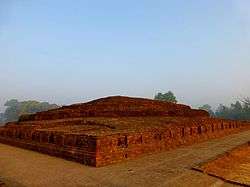 Stupa at Piprahwa
Stupa at Piprahwa
Ancient depictions
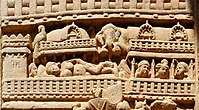 Maya's dream of an elephant during her conception of the Buddha, an identifier of the city of Kapilavastu.
Maya's dream of an elephant during her conception of the Buddha, an identifier of the city of Kapilavastu.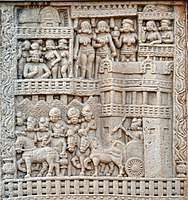 The departure of the Buddha from Kapilavastu, Sanchi, Stupa 1, Northern Gate.
The departure of the Buddha from Kapilavastu, Sanchi, Stupa 1, Northern Gate.
References
- Marshall, John (1918). Guide To Sanchi, Calcutta: ASI; p.64]
- Trainor, K (2010). "Kapilavastu". In Keown, D; Prebish, CS (eds.). Encyclopedia of Buddhism. Milton Park, UK: Routledge. pp. 436–7. ISBN 978-0-415-55624-8.
- Kapila, VEDIC SAGE, Encyclopedia Britannica . Link: https://www.britannica.com/biography/Kapila
- UP’s Piprahwa is Buddha’s Kapilvastu? ,Shailvee Sharda May 4, 2015, Times of India
- Beal, Samuel (1884). Si-Yu-Ki: Buddhist Records of the Western World, by Hiuen Tsiang. 2 vols. Translated by Samuel Beal. London. 1884. Reprint: Delhi. Oriental Books Reprint Corporation. 1969. Volume 1
- Beal, Samuel (1911). The Life of Hiuen-Tsiang. Translated from the Chinese of Shaman (monk) Hwui Li by Samuel Beal. London. 1911. Reprint Munshiram Manoharlal, New Delhi. 1973. Internet Archive
- Li, Rongxi (translator) (1995). The Great Tang Dynasty Record of the Western Regions. Numata Center for Buddhist Translation and Research. Berkeley, California. ISBN 1-886439-02-8
- Watters, Thomas (1904). On Yuan Chwang's Travels in India, 629-645 A.D. Volume1. Royal Asiatic Society, London.
- Tuladhar, Swoyambhu D. (November 2002), "The Ancient City of Kapilvastu - Revisited" (PDF), Ancient Nepal (151): 1–7
- Chris Hellier (March 2001). "Competing Claims on Buddha's Hometown". Archaeology.org. Retrieved 21 March 2011.
- Srivastava, KM (1979), "Kapilavastu and Its Precise Location", East and West, 29 (1/4): 61–74, JSTOR 29756506 – via JSTOR (subscription required)
- Srivastava, KM (1980). "Archaeological Excavations at Piprāhwā and Ganwaria and the Identification of Kapilavastu". The Journal of the International Association of Buddhist Studies. 13 (1): 103–10.
- Sharda, Shailvee (May 4, 2015), "UP's Piprahwa is Buddha's Kapilvastu?", Times of India
- "Kapilavastu". Retrieved 1 March 2011.
- Huntington, John C (1986), "Sowing the Seeds of the Lotus" (PDF), Orientations, September 1986: 54–56, archived from the original (PDF) on November 28, 2014
Bibliography
- Coningham, Robin; Young, Ruth (2015). The Archaeology of South Asia: From the Indus to Asoka, c.6500 BCE–200 CE. Cambridge University Press. pp. 438–440. ISBN 978-1-316-41898-7.
